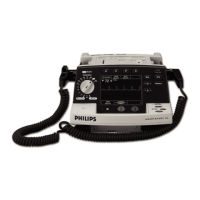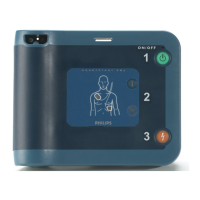5: Performance Verification Verification Test Equipment
156
Internal Repairs
If the case was opened (regardless of what else the repair involved), perform all the Performance
Verification and Safety tests:
Run the Performance Verification and Safety tests (see “Test and Inspection Matrix” on page 157
and “Performance Verification Procedures” on page 160).
Verification Test Equipment
Tab le 3 6 lists the equipment needed to perform the Performance Verification and Safety tests, and
provides specifications for commercially available analyzers and simulators. Test equipment is called out
within each test procedure when needed.
Table 36 Verification Test Equipment
Equipment Specification
ECG Simulator (for Leads/Pads/Paddles)
Leads simulated
Amplitude accuracy
Rate accuracy
3 and 5
±2%
±2%
Defibrillator Analyzer
Waveform compatibility
Load resistance
Maximum energy
Maximum voltage
Maximum current
Energy measurement accuracy
Cardioversion measurement range
Meets all specs below using biphasic
truncated exponential waveform
50 Ω ±1% (non-inductive)
≥ 200 J
≥ 2500 V
≥ 50 A
< 20 J: ≤ ±0.4 J;
≥ 20 J: ≤ ±2% of reading
–120 to +380 ms
Test Load
50 Ω ±1% (non-inductive)
Pacer test
Load impedance
Current measurement accuracy
Rate measurement accuracy
Waveform duration measurement accuracy
≤ 400 Ω
10 mA–50 mA: ≤ ±2 mA;
50 mA–175 mA: ≤ ±4%
30–180 ppm: ≤ ±0.5%
30–180 ppm: ±1 ms
NBP test
Pressure range
Pressure measurement accuracy
> 280 mmHg
±3 mmHg
Safety test
Leakage current measurement range
Leakage current measurement accuracy
0 – 5000 μA
±2% or ±2 μA

